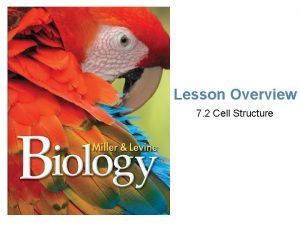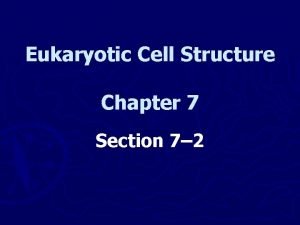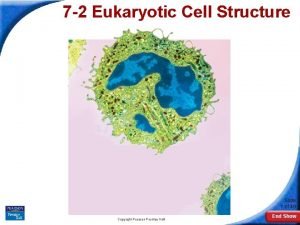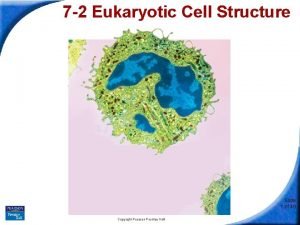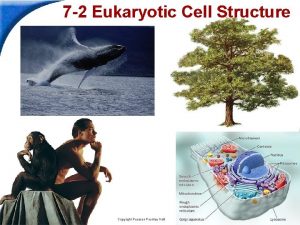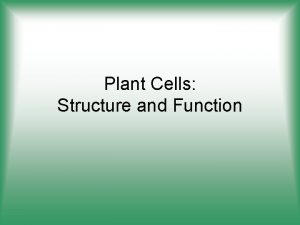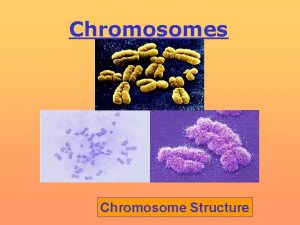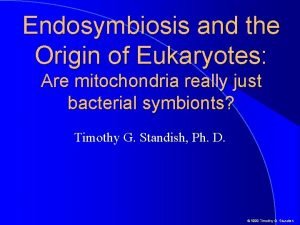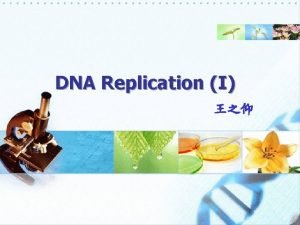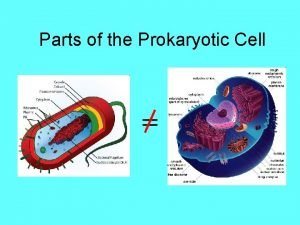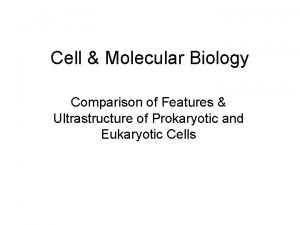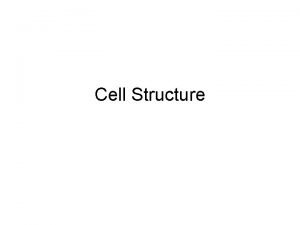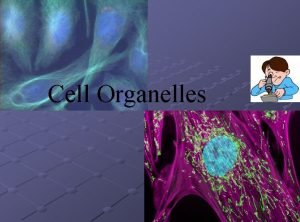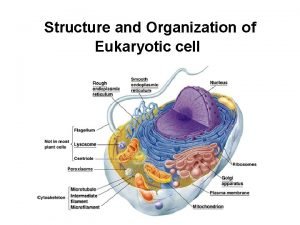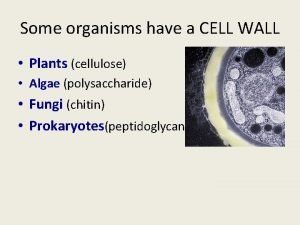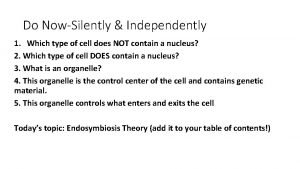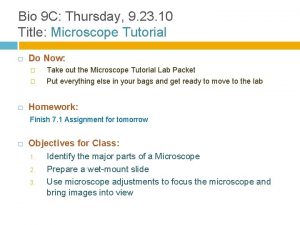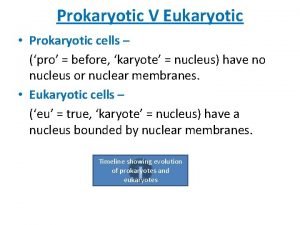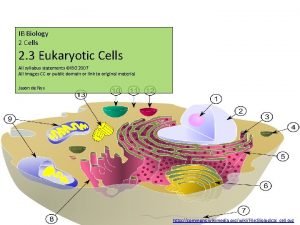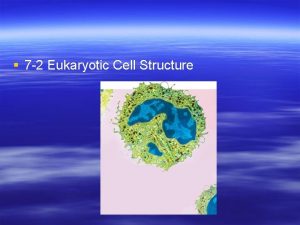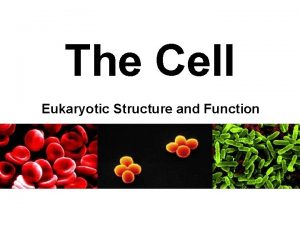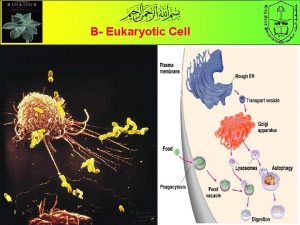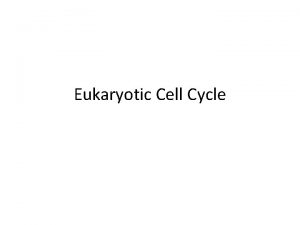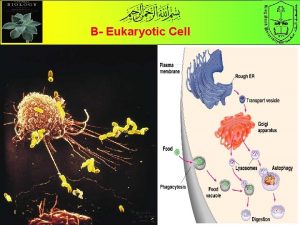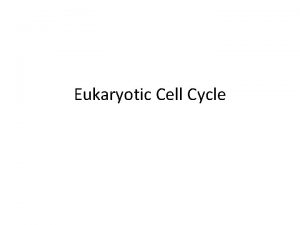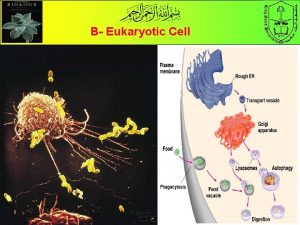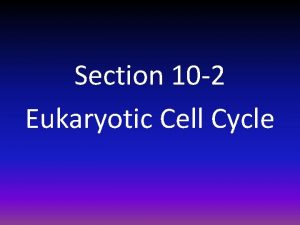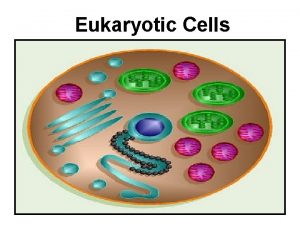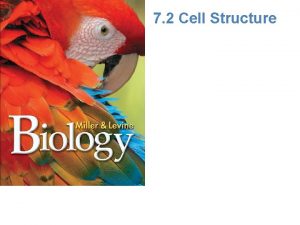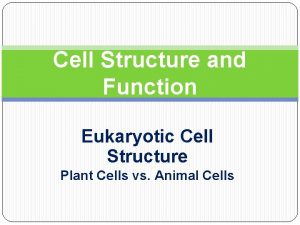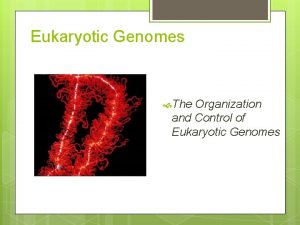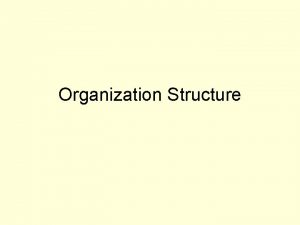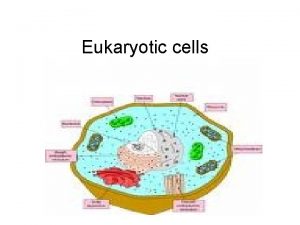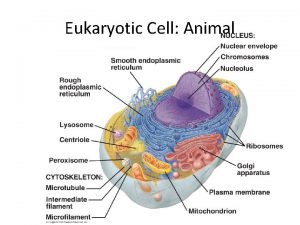Cell Structure Cell Organization The eukaryotic cell can













































- Slides: 45

Cell Structure

Cell Organization The eukaryotic cell can be divided into two major parts: the nucleus and the cytoplasm. The cytoplasm = the fluid portion of the cell outside the nucleus. Prokaryotic cells have cytoplasm as well, even though they do not have a nucleus.

Cell Organization Many cellular structures are specialized to perform important functions. These structures are known as organelles, literally “little organs. ” Understanding what each organelle does helps us to understand the cell as a whole.

Comparing the Cell to a Factory The eukaryotic cell is a lot like a living version of a factory. The specialized machines and assembly lines of the factory can be compared to the different organelles of the cell. Cells, like factories, follow instructions and produce products.

The Nucleus The nucleus contains nearly all the cell’s DNA and, with it, the coded instructions for making proteins and other important molecules. In the same way that the main office controls a large factory, the nucleus is the control center of the cell. Prokaryotes lack a nucleus, they DO contain DNA

The Nucleus The nucleus is surrounded by a nuclear envelope composed of two membranes. The nuclear envelope is dotted with thousands of nuclear pores, which allow material to move into and out of the nucleus.

The Nucleus Proteins, RNA, and other important molecules move through the nuclear pores to and from the rest of the cell. Like messages, instructions, and blueprints moving in and out of a main office

The Nucleus Chromosomes contain the genetic information that is passed from one generation of cells to the next. Most of the time, the threadlike chromosomes are spread throughout the nucleus in the form of chromatin—a complex of DNA bound to When a cell divides, its proteins. chromosomes condense and can be seen under a microscope.

The Nucleus Most nuclei also contain a small, dense region known as the nucleolus. The nucleolus is where the assembly of ribosomes begins

Organelles that Store, Clean Up, and Support What are the functions of vacuoles, lysosomes, and the cytoskeleton?

Organelles that Store, Clean Up, and Support What are the functions of vacuoles, lysosomes, and the cytoskeleton? STORAGE Vacuoles Lysosomes CLEAN UP Cytoskeleton SUPPORT

Vacuoles and Vesicles Many cells contain large, saclike, membrane -enclosed structures called vacuoles that store materials such as water, salts, proteins, and carbohydrates. Storage rooms

Vacuoles and Vesicles Plant cells = single, large central vacuole filled with liquid. The pressure of the central vacuole increases the rigidity, making it possible for plants to support heavy structures such as leaves and flowers.

Vacuoles and Vesicles Vacuoles are found in some unicellular organisms and in some animals. The paramecium contains an organelle called a contractile vacuole. By contracting rhythmically, this specialized vacuole pumps excess water out of the cell.

Vacuoles and Vesicles Nearly all eukaryotic cells contain smaller membrane-enclosed structures called vesicles. Vesicles are used to store and move materials between cell organelles, as well as to and from the cell surface.

Lysosomes are small organelles filled with enzymes that function as the cell’s cleanup crew. Lysosomes perform the vital function of removing “junk” that might otherwise accumulate and clutter up the cell. One function of lysosomes is the breakdown of lipids, carbohydrates, and proteins into small molecules that can be used by the rest of the cell.

Lysosomes are also involved in breaking down organelles that have outlived their usefulness. Cleaning crew Biologists once thought that lysosomes were only found in animal cells, but it is now clear that lysosomes are also found in a few specialized types of plant cells as well.

The Cytoskeleton Eukaryotic cells are given their shape and internal organization by a network of protein filaments known as the cytoskeleton. Steel and cement beams hold up walls and roof

The Cytoskeleton Certain parts of the cytoskeleton help to transport materials between different parts of the cell. Much like conveyer belts that carry materials from one part of the factory to another Microfilaments and microtubules are two of the principal protein filaments that make up the cytoskeleton.

Microfilaments are threadlike structures made up of a protein called actin. They form extensive networks in some cells and produce a tough, flexible framework that supports the cell. Microfilaments also help cells move. Microfilament assembly and disassembly is responsible for the cytoplasmic movements that allow cells, such as amoebas, to crawl along surfaces.

Microtubules are hollow structures made up of proteins known as tubulins. - maintain cell shape. - cell division = form the mitotic spindle, which helps to separate chromosomes. - build projections from cell surface = cilia and flagella, cell movement

Centrioles In animal cells, structures known as centrioles are also formed from tubulins. Centrioles are located near the nucleus and help to organize cell division. Centrioles are not found in plant cells.

Organelles That Build Proteins What organelles help make and transport proteins? Proteins are assembled on ribosomes

Ribosomes are small particles of RNA and protein found throughout the cytoplasm in all Each ribosome is like a small machine in a cells. factory, turning out proteins on orders that come from its DNA “boss” Ribosomes produce proteins by following coded instructions that come from DNA.

Endoplasmic Reticulum Eukaryotic cells contain an internal membrane system known as the endoplasmic reticulum, or ER. The endoplasmic reticulum is where lipid components of the cell membrane are assembled, along with proteins and other materials that are exported from the cell.

Rough Endoplasmic Reticulum Rough ER is given this name because of the ribosomes found on its surface. Newly made proteins leave these ribosomes and are inserted into the rough ER, where they may be chemically modified.

Smooth Endoplasmic Reticulum Smooth ER = NO ribosomes on surface Contains collections of enzymes that perform specialized tasks, including the synthesis of membrane lipids and the detoxification of drugs.

Golgi Apparatus Stack of flattened membranes Proteins from the ER are bundled into vesicles that carry them to the Golgi apparatus.

Golgi Apparatus The Golgi apparatus modifies, sorts, and packages proteins and other materials from the ER for storage in the cell or release outside the cell. Customization shop, where the finishing touches are put on proteins before they are ready to leave the “factory. ”

Organelles That Capture and Release Energy What are the functions of chloroplasts and mitochondria? Chloroplasts use energy from the sun to create food Mitochondria break down food to release energy

Chloroplasts capture energy from sunlight and convert it into food (photosynthesis) Solar panels

Mitochondria convert the chemical energy stored in food into compounds that are more convenient for the cell to use. Power Plant

Mitochondria One of the most interesting aspects of mitochondria is the way in which they are inherited. In humans, all or nearly all of our mitochondria come from the cytoplasm of the ovum, or egg cell. You get your mitochondria from Mom!

Chloroplasts and mitochondria contain their own genetic information in the form of small DNA molecules. The endosymbiotic theory suggests that chloroplasts and mitochondria may have descended from independent microorganisms.

Cellular Boundaries What is the function of the cell membrane? The cell membrane regulates what enters and leaves the cell and also protects and supports the cell.

Walls and roof of factory that protect it from environment outside Cells are surrounded by a barrier known as the cell membrane. Many cells, including most prokaryotes, also produce a strong supporting layer around the membrane known as a cell wall.

Cell Wall The main function is to provide support and protection for the cell. Prokaryotes, plants, algae, fungi have cell walls. Animal cells do not have cell walls. Cell walls lie outside the cell membrane Porous enough to allow water, oxygen, carbon dioxide, and certain other substances to pass through easily.

Cell Membrane • All cells have a cell membrane • Regulates what enters and leaves the cell • Protects and supports the cell

Cell Membrane Cell membranes are a double-layered sheet called a lipid bilayer, which gives cell membranes a flexible structure and forms a strong barrier between the cell and its surroundings.

The fatty acid portions of a lipid are hydrophobic, or “water-hating, ” while the opposite end of the molecule is hydrophilic, or “water-loving. ”

When such lipids are mixed with water, their hydrophobic fatty acid “tails” cluster together while their hydrophilic “heads” are attracted to water. A lipid bilayer is the result. Hydrophilic head Hydrophobic tail

Fluid Mosaic Model Most cell membranes contain protein molecules that are embedded in the lipid bilayer. Carbohydrate molecules are attached to many of these proteins. Hydrophilic head Hydrophobic tail

Fluid Mosaic Model Because the proteins embedded in the lipid bilayer can move around and “float” among the lipids, and because so many different kinds of molecules make up the cell membrane, scientists describe the cell membrane as a “fluid mosaic. ” Hydrophilic head Hydrophobic tail

Fluid Mosaic Model Some of the proteins form channels and pumps that help to move material across the cell membrane. Many of the carbohydrate molecules act like chemical identification cards, allowing individual cells to identify one another. Hydrophilic head Hydrophobic tail

Security guard Not everything can cross biological membranes, some are too large or too strongly charged to cross the lipid bilayer. If a substance is able to cross a membrane, the membrane is said to be permeable to it. A membrane is impermeable to substances that cannot pass across it. Most biological membranes are selectively permeable, some substances can pass across them and others cannot. Also called semipermeable membranes.
 Cell structure
Cell structure The distinct threadlike structures that contain the genetic
The distinct threadlike structures that contain the genetic Biology chapter 7 cell structure and function
Biology chapter 7 cell structure and function Eukaryotic cell
Eukaryotic cell 7-2 eukaryotic cell structure
7-2 eukaryotic cell structure Section 7-2 eukaryotic cell structure
Section 7-2 eukaryotic cell structure Eukaryotic plant cell diagram
Eukaryotic plant cell diagram Site:slidetodoc.com
Site:slidetodoc.com Prokaryotic cell and eukaryotic cell similarities
Prokaryotic cell and eukaryotic cell similarities Life
Life Carbohydrate side chain
Carbohydrate side chain Eukaryota
Eukaryota How to read chromosome
How to read chromosome Telophase
Telophase Eukaryotic chromosome structure
Eukaryotic chromosome structure Eukaryotic chromosome structure
Eukaryotic chromosome structure Is an amoeba a prokaryote
Is an amoeba a prokaryote Typical eukaryotic cell
Typical eukaryotic cell Eukaryotic cell organisation
Eukaryotic cell organisation Cytoskeleton prokaryotic or eukaryotic
Cytoskeleton prokaryotic or eukaryotic Eukaryotic cells
Eukaryotic cells Are cell walls prokaryotic or eukaryotic
Are cell walls prokaryotic or eukaryotic Eukaryotic cell
Eukaryotic cell Are plants multicellular eukaryotes
Are plants multicellular eukaryotes Eukaryotic cell questions
Eukaryotic cell questions Cell organelle
Cell organelle Karyote
Karyote Eukaryotic cell
Eukaryotic cell Ib biology eukaryotic cell diagram
Ib biology eukaryotic cell diagram Prokaryotic cells
Prokaryotic cells Process organization in computer organization
Process organization in computer organization Point by point organization essay
Point by point organization essay Hát kết hợp bộ gõ cơ thể
Hát kết hợp bộ gõ cơ thể Lp html
Lp html Bổ thể
Bổ thể Tỉ lệ cơ thể trẻ em
Tỉ lệ cơ thể trẻ em Voi kéo gỗ như thế nào
Voi kéo gỗ như thế nào Chụp tư thế worms-breton
Chụp tư thế worms-breton Chúa yêu trần thế alleluia
Chúa yêu trần thế alleluia Các môn thể thao bắt đầu bằng từ đua
Các môn thể thao bắt đầu bằng từ đua Thế nào là hệ số cao nhất
Thế nào là hệ số cao nhất Các châu lục và đại dương trên thế giới
Các châu lục và đại dương trên thế giới Công thức tiính động năng
Công thức tiính động năng Trời xanh đây là của chúng ta thể thơ
Trời xanh đây là của chúng ta thể thơ Cách giải mật thư tọa độ
Cách giải mật thư tọa độ Phép trừ bù
Phép trừ bù
